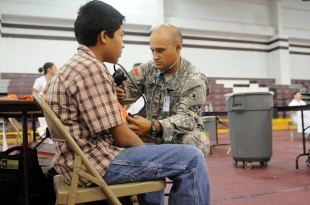Texans Support the Valley With Humanitarian Mission
Staff Sgt. Daniel Griego, 100th Mobile Public Affairs Detachment
2010/07/29
 "Operation Lone Star is a humanitarian effort here in the valley," said State Guard Lt. Col. Jann Melton-Kissel, a registered nurse with the Texas State Guard's Medical Brigade. "It's a partnership between the Department of State Health Services, the Texas Military Forces and the community to provide needed health services."
"Operation Lone Star is a humanitarian effort here in the valley," said State Guard Lt. Col. Jann Melton-Kissel, a registered nurse with the Texas State Guard's Medical Brigade. "It's a partnership between the Department of State Health Services, the Texas Military Forces and the community to provide needed health services."
These services, which include immunizations, physicals, diabetes screenings and check-ups, come to Texas' Rio Grande Valley residents each year courtesy of the collaborative efforts of state civil and military assets. Together, these disparate agencies provide low-income families with necessary and sometimes life-saving medical care through the annual Operation Lone Star (OLS).
"It's been a real privilege to work with our colleagues in the Texas Military Forces," said Dr. Brian R. Smith, lead for the Department of State Health Services (DSHS) and regional medical director for Health Service Region 11.
Smith began OLS in 1999 as a joint venture expanding on his efforts with free clinics in the valley.
"I started off in South Texas doing free clinics," he said, "and this is a larger scale extension of what I started off doing about 20 years ago, which was providing free medical care in the [valley]. So the first places we started [OLS] were the same places that we were doing our the free clinics."
To augment the medical specialties of the DSHS, several other civilian agencies also contributed personnel, including the Texas Medical Assistance Team (TexMAT-1), the Department of Family Protective Services, the Human Health Services Committee and even local nursing students from Valley Grande Community College.
"It's a great opportunity to get people of all different types of disciplines in the medical field to get together and work," said Charles Neely, an EMT paramedic with TexMAT-1.
The military side of OLS, the Texas Military Forces, includes the Texas State Guard, Army National Guard, and Air Guard. These uniformed personnel function as both duty and medical support, performing roles ranging from security and administration to nurses and doctors. In recent years, the State Guard has taken the lead in executing OLS, providing the greatest number of personnel and assuming command responsibilities of the operation.
"We're working together as a team," said State Guard 1st Lt. Steven Trevino, a registered nurse with the Texas Medical Brigade. "We're just Texans helping Texans."
As a regularly scheduled exercise, OLS finds many of the same residents returning time and again for annual shots and physicals for school sports.
"I would just like to thank the Lone Star for coming in and doing the medical check-up for free," said Brenda Garcia, a Palmview resident and mother of a 2-year-old.
"This'll be my seventh year here," said Melton-Kissel. "I've seen the same people come back year after year."
OLS provides a unique opportunity for local residents to see their community support agencies face to face and meet the people behind the uniforms.
"I feel like I'm actually making a difference," said Trevino.
Texas State Guard Capt. James R. Owens, a registered nurse with the DFW Medical Group, says that the most rewarding aspect of working in OLS is "being able to serve the valley and the people of the valley, and also help our state out."
"We've got compassionate doctors who do a really good job with the health care," said Smith. "Then we're able to expand it with the pharmacy, the immunizations and provide a range of services."
To combat the occasional language barrier found in southern towns, OLS staffs each location with sufficient bi-lingual personnel to ensure the most accurate and complete medical coverage.
"As translators, we make sure we get the right words [patients] are looking for," said State Guard Sgt. Erasmo Chapa, translator and security service member for the Palmview High School location. "This is my first year and I'm glad to help out my community."
From the inter-agency cooperation to building strong bonds in the community, OLS stands apart as a joint mission that excels at bringing people together.
"It has been a real blessing," said Smith, "to be able to work with communities this closely."